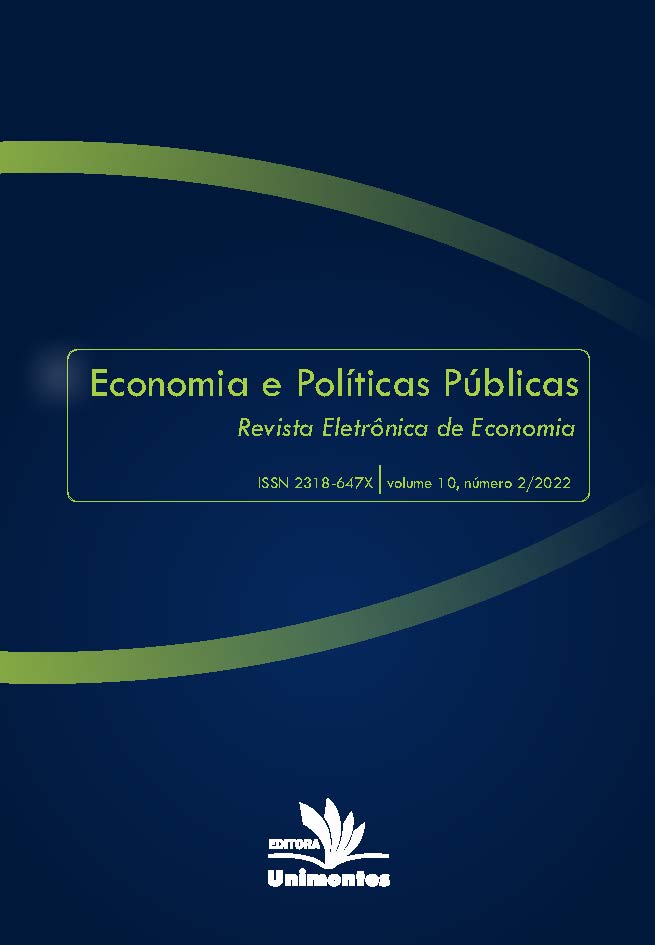A Elasticidade De Substituição entre Capital-Energia para Países Desenvolvidos e em Desenvolvimento
DOI:
https://doi.org/10.46551/epp2021940Resumen
O objetivo deste trabalho é analisar o grau de substituição entre capital e energia para países da Organização para a Cooperação e Desenvolvimento Econômico (OCDE) e países em desenvolvimento no período de 1990 a 2014. Para este fim, a função de produção CES (Constant Elasticity of Substitution) para dois fatores foi estimada por meio do método generalizado dos momentos (GMM - Generalized Method of Moments). Os principais resultados apontam elasticidade de substituição igual a 1,451 e 2,934 para os países da OCDE e das nações em desenvolvimento, respectivamente. Desse modo, capital e energia podem ser considerados substitutos imperfeitos, isto é, há possibilidades de trocas entre os fatores, porém, não é possível se especializar em
apenas um deles. Diante desses achados, pode-se concluir que os custos de mitigação das emissões são possivelmente menores nas economias em desenvolvimento, visto que há maior oportunidade de substituição entre fatores.
Palavras-chave: Capital. Energia. Elasticidade de substituição. Função CES.
Descargas
Citas
ADETUTU, M. O. Energy efficiency and capital-energy substitutability: Evidence from four OPEC countries. Applied Energy, n. 119, p. 363-
, 2014.
ARNBERG, Søren; BJØRNER, Thomas Bue. Substitution between energy, capital and labour within industrial companies: A micro panel data analysis. Resource and Energy Economics, v. 29, n. 2, p. 122-136, 2007.
BANCO MUNDIAL. World Bank Group, 2015. Disponível em: . Acesso em: Maio 2018.
BERNDT, Ernst R.; WOOD, David O. Engineering and econometric interpretations of energy-capital complementarity. The American Economic Review, v. 69, n. 3, p. 342-354, 1979.
CHIU, Sung Nok et al. Stochastic geometry and its applications. John Wiley & Sons, 2013
COSTANTINI, V.; PAGLIALUNGA, E. Elasticity of substitution in capital- energy relationships: how central is a sector-based panel estimation approach? SEEDS WP, v.13, 2014.
FUSS, Melvyn A. The demand for energy in Canadian manufacturing: An example of the estimation of production structures with many inputs. Journal of econometrics, v. 5, n. 1, p. 89-116, 1977.
GRIFFIN, J.M.; GREGORY, P.R. An intercountry translog model of energy substitution responses. The American Economic Review, v. 66, n. 5, p. 845-857, 1976.
GUJARATI, Damodar N; PORTER, Dawn C. Econometria basica. 5. ed. Rio de Janeiro: AMGH, 2011.
HICKS, John. Elasticity of substitution again: substitutes and complements. Oxford economic papers, v. 22, n. 3, p. 289-296, 1970.
IPCC (2013) INTERGOVERNMENTAL PANEL ON CLIMATE CHANGE, IPCC. Summary for Policymakers. In: Climate Change 2013: The Physical Science Basis. Contribution of Working Group I to the Fifth Assessment Report of the Intergovernmental Panel on Climate Change [Stocker, T.F. et al. (Eds.)]. Cambridge University Press, Cambridge, United Kingdom and New York, NY, USA, 2013.
KEMFERT, Claudia. Estimated substitution elasticities of a nested CES production function approach for Germany. Energy Economics, v. 20, n. 3, p. 249-264, 1998.
KEMFERT, Claudia; WELSCH, Heinz. Energy-capital-labor substitution and the economic effects of CO 2 abatement: evidence for Germany. Journal of Policy Modeling, v. 22, n. 6, p. 641-660, 2000.
KMENTA, J. On estimation of the CES production function. International Economic Review, v. 8, n. 2, p. 180-189, 1967.
KOETSE, Mark J.; DE GROOT, Henri LF; FLORAX, Raymond JGM. Capital-energy substitution and shifts in factor demand: A meta- analysis. Energy Economics, v. 30, n. 5, p. 2236-2251, 2008.
OLLEY, G. S.; PAKES, A. The dynamics of productivity in the telecommunications equipment industry. Econometrica, v. 64, n. 6, p. 1263-1297, 1996.
PINDYCK, Robert S. Interfuel substitution and the industrial demand for energy: an international comparison. The Review of Economics and Statistics, p. 169-179, 1979.
SHASHUA, L.; MELNIK, A.; GOLDSCHMIDT, Y. A note on stock and flow capital inputs in the production function of multi-product firms. Applied Economics, v. 6, n. 3, p. 229-233, 1974.
VARIAN, H. R. Microeconomic Analysis, WW Norton&Company. Inc, New York, New York, 1992.
WOOLDRIDGE, Jeffrey M. Introductory econometrics: A modern approach. Cengage learning, 2015.
ZHA, Donglan; DING, Ning. Elasticities of substitution between energy and non-energy inputs in China power sector. Economic Modelling, v. . 564-571, 2014.
Descargas
Publicado
Cómo citar
Número
Sección
Licencia
Derechos de autor 2023 Revista de Economía y Políticas Públicas

Esta obra está bajo una licencia internacional Creative Commons Atribución-NoComercial-SinDerivadas 4.0.
Os trabalhos publicados não serão remunerados em hipótese alguma.
O (s) autor (es), ao submeterem o trabalho à análise, automaticamente cedem os direitos de publicação à Revista, em sua versão eletrônica. e/ou impressa (A revista também será impressa e depositada em algumas bibliotecas de referência) licenciado sob a Licença Creative Commons Attribution (CC BY-NC-ND 4.0).
Os autores dos trabalhos aprovados NÃO terão direito a qualquer exemplar da edição em que constar sua publicação, pois trata-se de versão eletrônica.
Serão aceitos trabalhos com, no máximo, três autores.
Todos os casos não previstos serão analisados e decididos pelo Conselho Editorial que, dentre outras atribuições, ficará encarregada de informar aos autores da possibilidade da publicação, contra os quais não caberá recurso.





















